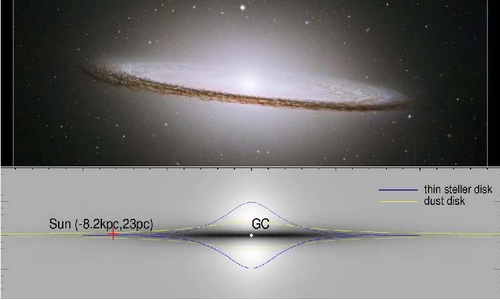The spatial distribution of dust in galaxies provides important information about the structure and evolution of galaxies. Observations of extragalactic galaxies show that dust is abundant in disk-like galaxies, which also forms a remarkable disk-like structure. In general, dust disks appear radially more extended and thinner than stellar disks. As shown in the Figure below,the different spatial distributions of dust and stars make up the famous image of the Sombrero Galaxy.
Recently, a group of researchers at Shanghai Astronomical Observatory of Chinese Academy (SHAO) of Sciences have made an accurate modelling of the structure of dust component in the Milky Way, and given the most accurate scale of the Galactic dust distribution so far, using the massive stellar spectral data obtained by LAMOST survey. This study has been accepted for publication in the Astrophysical Journal. (https://arxiv.org/abs/1803.10540)
Using the stellar spectra from LAMOST survey, a team of researchers led by Professor LIU Xiaowei of Peking University made an independent analysis of the stellar spectra and released a value-added catalog of a sample of millions stars, which listed the interstellar dust extinction values toall the sample stars. Using these extinction values, LI Linlin, Ph.D student of SHAO, supervised by Professor SHEN Shiyin, has successfully constructed an analytical model for the overall spatial distribution of the interstellar dust in the Milky Way.
This study shows that the overall distribution of the interstellar dust in the Milky Way can be well described by a disk-like structure with an exponential decrease in both radial and vertical densities, after subtracting two very prominent substructures near the sun. The scale-length of the dust disk is up to 10,000 light-years, while the scale-height is only about 330 light-years. In contrast to the structural parameters of the Milky Way's stellar disks, also based on LAMOST survey data, the Galactic dust disk is also more stretched on the radial scale and thinner in the vertical. That is to say, if we are far enough away, the Milky Way we see will be very similar to Sombrero Galaxy from the edge-on view.
.
This research has achieved unprecedented precision in measuring the overall structure of the Milky Way dust component, which is attributed to the massive data provided by LAMOST to a certain extent.

Figure: Image of the Sombrero Galaxy(also known as M104) from Hubble space telescope(up). Cartoon of the dust and stellar distribution of Milky Way from LAMOST data(bottom).

Address: 20A Datun Road, Chaoyang District, Beijing, China code: 100012
Tel: 010-64888708 E-mail: naoc@nao.cas.cn

